What are dashes? How do I use dashes in writing? What are the grammar rules that govern the various types of dashes? A dash is a small horizontal line that is used as a punctuation mark in the English language. It resembles the hyphen (a punctuation mark used to separate individual words) in appearance, although it is longer and occasionally higher than the baseline. It is used to denote a pause or a range and is used to divide word groups rather than individual words.
Dash types (em dash and en dash)
The different styles of dashes include the en dash “–”, the em dash “—”, and the horizontal bar “―”. The em dash “—” and the en dash “–” are the two most popular dash forms. These dashes differ not only in their length but also in the function they perform in a sentence. Authors can easily remember the difference between these dashes by remembering the length of the alphabets “M” and “N.”
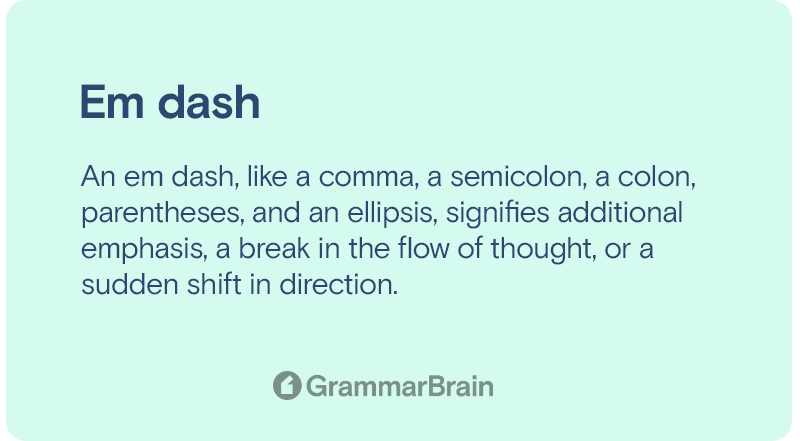
Em dashes
An em dash, like a comma, a semicolon, a colon, parentheses, and an ellipsis, signifies additional emphasis, a break in the flow of thought, or a sudden shift in direction.
Em dashes, for example, can take the place of parentheses when there are numerous commas in the parenthetical phrase.
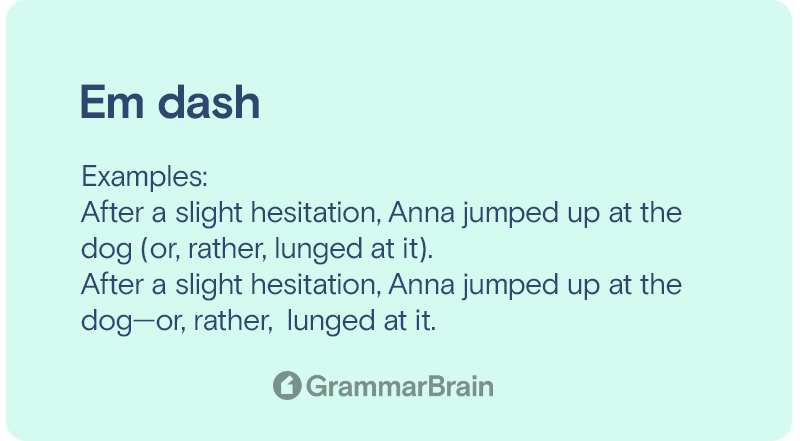
Consider the following example:
- After a slight hesitation, Anna jumped up at the dog (or, rather, lunged at it).
- After a slight hesitation, Anna jumped up at the dog—or, rather, lunged at it.
An author can use colons to begin a clause that expands on the text that came before it. Colons are much more formal when compared to dashes. Em dashes, however, are more forceful than colons. Authors typically use em dashes to convey strong emotion or to give their text a more informal tone.
Consider the following example:
- Anna is terrified of two things: lizards and dancing.
- Anna is terrified of two things—lizards and dancing.
Em dashes are used by transcriptionists and authors to substitute letters that are obscure, censored, or purposefully deleted. Em dashes show up in groups of two or three in these instances.
Consider the following example:
A former member of the disgraced team, — — —, provided his statement at court today.
At the end of the letter was a fading sentence: “Love you, Anna, from your de— —ted friend.”
“H— — always get on my nerves. All they know is how to cause trouble everywhere they go.”
Some rules for em dashes
There are some important rules that authors should be careful about when using dashes. These include:
Rule 1
Phrases and words between dashes typically do not belong in the subject.
Example:
Anna—and her lovely pooch—is always welcome here for the Christmas holidays.
Rule 2
When necessary, dashes take the place of mandatory punctuation.
Example:
Without dash: The woman from Manila, Philippines, arrived.
With dash: The woman—she was from Manila, Philippines—arrived.
Rule 3
Spaces around the dash are preferred by some authors and publishers.
Example:
Without space: Anna—and her lovely pooch—is always welcome here for the Christmas holidays.
With space: Anna — and her lovely pooch — is always welcome here for the Christmas holidays.
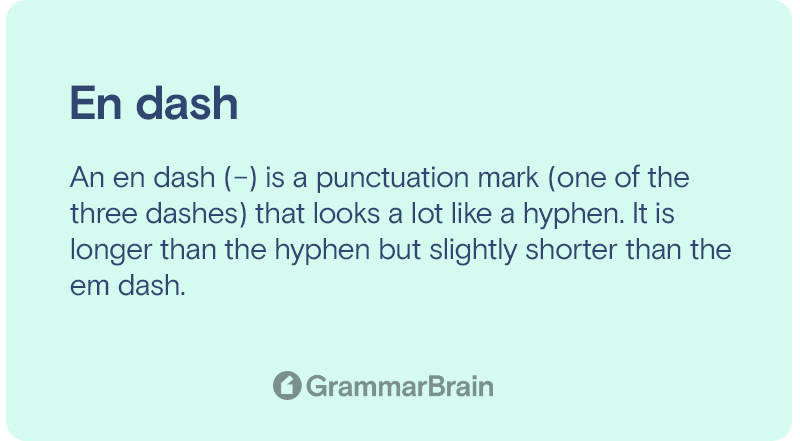
En dashes
An en dash is slightly shorter than an em dash in length. Despite having a similar appearance to em dashes, en dashes serve a very different purpose. Some common uses of the en dash include:
Indicate a link or connection
A connection or association between two words can be shown with an en dash. Authors typically use en dashes when employing a phrase with two words as a modifier. It is also used for connecting terms that have already been hyphenated. This method of dash usage results in compound adjectives.
Consider the following examples:
- The pro-life–pro-choice debate always sees a high amount of emotional arguments and appeals and ends in heated exchanges.
- The Nobel Peace Prize-winning humanitarian is the keynote speaker for the symposium organized by the charity.
Indicate a range of numbers or span of time
En dashes are frequently used to denote time periods or numerical ranges. The en dash in such sentences is used to represent either “through” or “to.”
Consider the following example:
- The parent-teacher meeting is scheduled to be conducted on Friday, 11:00-11:30 a.m.
- During the years 2002-2010, Anna lived in Manhattan, New York.
- We expect 25-50 celebrities at the gala.
- The tutor asked me to read pages 10–25 as homework for today.
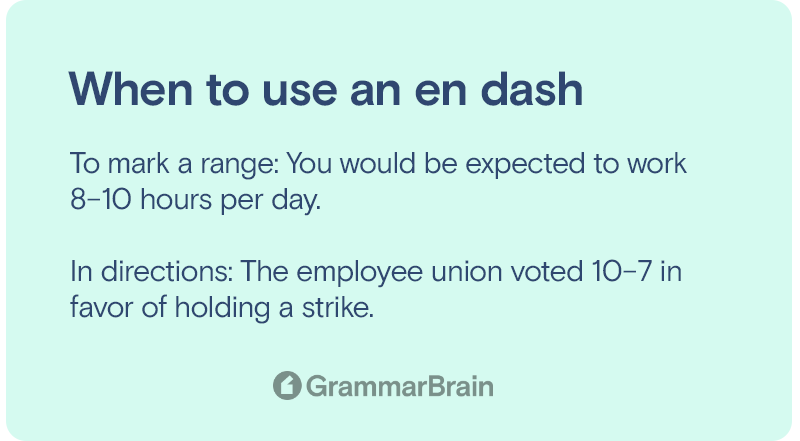
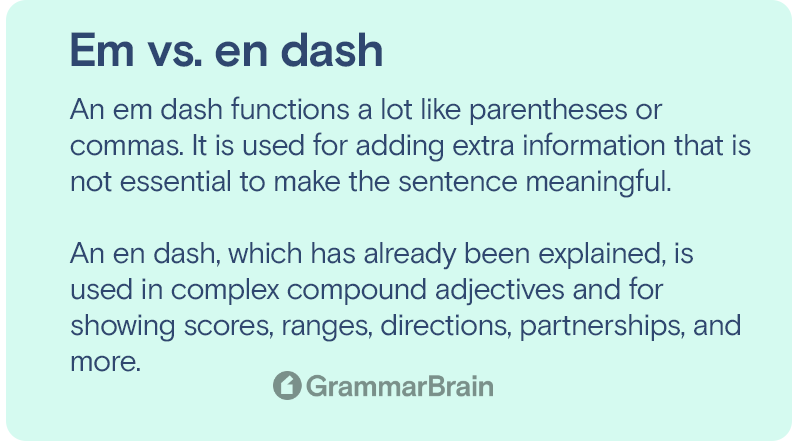
More punctuation marks (all 26 marks)
| Symbol | Name | Example |
| . | Period | I got this at the fair. |
| ? | Question mark | How many trucks does he have? |
| ! | Exclamation point | Wow! You’re a great rider. |
| , | Comma | I like the movie, but the color grading is odd to me. |
| : | Colon | Here are some fun ideas for the party: trivia questions, shuffle board, and more. |
| ; | Semicolon | I’ll visit you once I’m done with work; that’s a promise. |
| – | Hyphen | I have double-life situations. |
| – | En dash | How long is a China-Russia fight? |
| — | Em dash | The dog—and I’m afraid of four-legged animals—was so adorable. |
| ( ) | Parentheses | His favorite team (Chicago Bulls) has a chance to win the title. |
| [ ] | Square brackets | The AP writer said “[head] of baseball operations was disappointed.” |
| { } | Curly brackets | The colors {orange, green, lilac, blue} are for the garage. |
| < > | Angle brackets | |
| “ ” | Quotation marks | Bryan called it a “great situation.” |
| ‘ | Apostrophe | Some of Susan’s clothes are missing. |
| / | Slash or Virgule | I’m ordering food/dessert/more. |
| … | Ellipses | According to the school the “president… was disappointed.” |
| * | Asterisk | *Data from The Economist |
| & | Ampersand | Tiffany & Co. |
| • | Bullet point | • Simple • Great • Awesome |
| # | Pound symbol | #1 selling |
| ~ | Tilde | Bryan owns ~10 pairs of shoes. |
| \ | Backslash | |
| @ | At symbol | mary@gmail.com |
| ^ | Caret symbol | 3^3 = 27 |
| | | Pipe symbol |
FAQs
Is there any difference in the use of the em dash in American and British English?
In both American and British English, the em dash serves the same purpose. But there is a slight difference in the way the dash is represented in text. In British English, the dash is written as a single hyphen since most computer keyboards do not provide a separate dash.
In American English, the em dash is written with two consecutive hyphens. This is done to avoid any ambiguity that may crop up when a reader is perusing the text.
What is the difference between a hyphen and a dash?
A dash divides words into parenthetical phrases, whereas a hyphen links two or more words together. While dashes are separated using spaces, hyphens are not separated using them. A hyphen can be used to join compound words when it is grammatically appropriate to do so.
For example, consider the following:
- Compound words that are hyphenated: sister-in-law, seven-year-old.
- Spelled out fractions: three-fifths, one-third.
- Compound adjectives: pet-friendly cafe, well-oiled tool.
How do I create an em dash on my computer?
In Unicode, the em dash is U+2014. If you are using em dashes in your content, don’t put a space between them. A spaced em dash creates a unique reading flow. Although, a spaced en dash is considered okay.
What is a double hyphen?
A double hyphen is not considered a dash. It is its own form of punctuation mark.
Sources:
- Merriam Webster – dash – Definition
- Wikipedia – Dash
- Grammar Monster – Using Dashes
- Yourdictionary – 3 Types of Dashes and Correct Usage in Writing
Inside this article
Fact checked:
Content is rigorously reviewed by a team of qualified and experienced fact checkers. Fact checkers review articles for factual accuracy, relevance, and timeliness. Learn more.
Core lessons
Glossary
- Abstract Noun
- Accusative Case
- Anecdote
- Antonym
- Active Sentence
- Adverb
- Adjective
- Allegory
- Alliteration
- Adjective Clause
- Adjective Phrase
- Ampersand
- Anastrophe
- Adverbial Clause
- Appositive Phrase
- Clause
- Compound Adjective
- Complex Sentence
- Compound Words
- Compound Predicate
- Common Noun
- Comparative Adjective
- Comparative and Superlative
- Compound Noun
- Compound Subject
- Compound Sentence
- Copular Verb
- Collective Noun
- Colloquialism
- Conciseness
- Consonance
- Conditional
- Concrete Noun
- Conjunction
- Conjugation
- Conditional Sentence
- Comma Splice
- Correlative Conjunction
- Coordinating Conjunction
- Coordinate Adjective
- Cumulative Adjective
- Dative Case
- Determiner
- Declarative Sentence
- Declarative Statement
- Direct Object Pronoun
- Direct Object
- Diction
- Diphthong
- Dangling Modifier
- Demonstrative Pronoun
- Demonstrative Adjective
- Direct Characterization
- Definite Article
- Doublespeak
- False Dilemma Fallacy
- Future Perfect Progressive
- Future Simple
- Future Perfect Continuous
- Future Perfect
- First Conditional
- Irregular Adjective
- Irregular Verb
- Imperative Sentence
- Indefinite Article
- Intransitive Verb
- Introductory Phrase
- Indefinite Pronoun
- Indirect Characterization
- Interrogative Sentence
- Intensive Pronoun
- Inanimate Object
- Indefinite Tense
- Infinitive Phrase
- Interjection
- Intensifier
- Infinitive
- Indicative Mood
- Participle
- Parallelism
- Prepositional Phrase
- Past Simple Tense
- Past Continuous Tense
- Past Perfect Tense
- Past Progressive Tense
- Present Simple Tense
- Present Perfect Tense
- Personal Pronoun
- Personification
- Persuasive Writing
- Parallel Structure
- Phrasal Verb
- Predicate Adjective
- Predicate Nominative
- Phonetic Language
- Plural Noun
- Punctuation
- Punctuation Marks
- Preposition
- Preposition of Place
- Parts of Speech
- Possessive Adjective
- Possessive Determiner
- Possessive Case
- Possessive Noun
- Proper Adjective
- Proper Noun
- Present Participle
- Prefix
- Predicate



